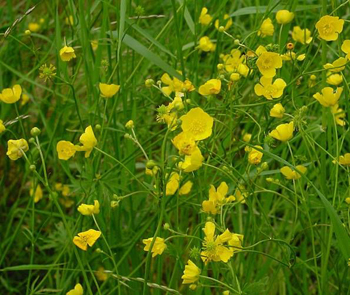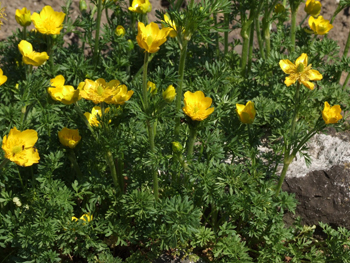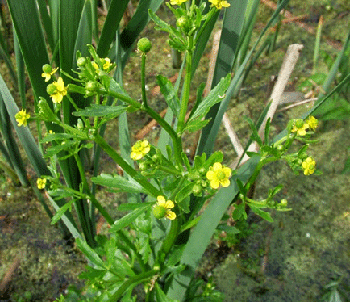Contents:
Common Names | Parts Usually Used | Plant(s) & Culture | Where Found | Medicinal Properties
Legends, Myths and Stories | Uses | How Sold | Warning | Bibliography
Scientific Names

Ranunculus acris |

Ranunculus bulbosus |
 Ranunculus sceleratus |
- Common or Tall
- Ranunculus acris L.
- Ranunculus bulbosus
- Ranunculus sceleratus
- Ranunculaceae
- Ranunculus
- Buttercup family
Common Names
Ranunculus acris L.:
- Bachelor’s buttons
- Blisterweed
- Burrwort
- Crowfoot
- Crowfoot buttercup
- Globe amaranth
- Gold cup
- Meadowbloom
- Meadow crowfoot
- Tall field buttercup
- Tall crowfoot
- Yellows
- Yellowweed
Ranunculus bulbosus:
- Acrid crowfoot
- Bulbous buttercup
- Crowfoot
- Crowfoot buttercup
- Cuckoo buds
- Frogwort
- King’s cup
- Marsh crowfoot
- Meadowbloom
- Pilewort
- St. Anthony’s turnip
Ranunculus sceleratus:
- Celery-leaved buttercup
- Cursed crowfoot
- Water crowfoot
Parts Usually Used
Roots and leaves, sometimes flowers and/or fresh plant. Only the fresh plant is poisonous and effective medicinally.
Back to Top
Description of Plant(s) and Culture
Ranunculua acris:
Erect annual or perennial, 2-3 feet tall. Leaves palmately divided into 5-7 stalkless, lance-shaped, toothed segments. Flowers are shiny; golden yellow within, lighter outside; blooms May to September. Fruits are flat, smooth, with distinct margins.
Ranunculus bulbosus:
Bulbous buttercup is a perennial plant. The hairy stem grows 6-8 inches high above the ground and swells out into a solid, fleshy bulb, or corm, under the ground. Small, fibrous roots grow from the bottom of the bulb. The long-petioled basal leaves are three-parted, with the leaflets three-lobed. The upper leaves are pinnate, with narrow leaflets. Several golden-yellow flowers appear on each stem from May to July.
Ranunculus sceleratus:
An annual or biennial plant, the fibrous root sends a stiff, hollow, glabrous, branched stem to a height of 6-18 inches. The leaves are thick, light green, shiny, and palmately lobed. Pale yellow flowers appear between May and November.
Back to Top
Where Found
Ranunculus acris: found in fields throughout the U.S. but mostly absent from the prairies. Ranunculus bulbosus: found in fields, pastures, and dry meadows of the northeastern U.S. and some Pacific coastal areas. Marsh crowfoot is found in wet, marshy places in the northern U.S., the western coastal states, and Canada.
Back to Top
Medicinal Properties
Counterirritant, anodyne, antispasmodic, diaphoretic; external rubefacient, epispastic
Back to Top
Legends, Myths and Stories
There are 250 species of buttercup that are native in cold climates throughout the Untied States and Europe.
Back to Top
Uses
Fresh leaves historically used as external rubefacient in rheumatism, gout, arthritis, neuralgia (topically or externally applied). American Indians poulticed root for eczema, warts, boils or abscesses. Action based on irritating affected part.
It is directly applied to warts.
A tincture may be both externally applied or taken internally to treat shingles and sciatica.
Back to Top
How Sold
Tincture (6-9 drops internally)
Back to Top
Warning
Extremely acrid, causing intense pain and burning of mouth, mucous membranes; blisters skin.
External application may cause blisters and lead to ulceration with prolonged use. Internal overdose may cause gastroenteritis.
Avoid use. Similar warning applies to other buttercups, and many other plants in the buttercup family. Marsh crowfoot is the most active of the three buttercup species; mere contact with the skin can cause irritation and blistering. Do not use internally.
Do not use without medical supervision.
Back to Top
Bibliography
![]() The Herb Book
The Herb Book, by John Lust, Bantam Books, 666 Fifth Avenue, New York, NY. copyright 1974.
![]() Indian Herbalogy of North America
Indian Herbalogy of North America, by Alma R. Hutchens, Shambala Publications, Inc., Horticultural Hall, 300 Massachusetts Avenue, Boston, Massachusetts 02115, 1973
![]() Indian Uses of Native Plants
Indian Uses of Native Plants, by Edith Van Allen Murphey, Meyerbooks, publisher, PO Box 427, Glenwood, Illinois 60425, copyright 1958, print 1990
![]() Eastern/Central Medicinal Plants
Eastern/Central Medicinal Plants, by Steven Foster and James A. Duke., Houghton Mifflin Company, 215 Park Avenue South, New York, NY 10000
![]() Planetary Herbology
Planetary Herbology, by Michael Tierra, C.A., N.D., O.M.D., Lotus Press, PO Box 325, Twin Lakes. WI 53181., Copyright 1988, published 1992
![]() Webster’s New World Dictionary
Webster’s New World Dictionary, Third College Edition, Victoria Neufeldt, Editor in Chief, New World Dictionaries: A Division of Simon & Schuster, Inc., 15 Columbus Circle, New York, NY 10023
